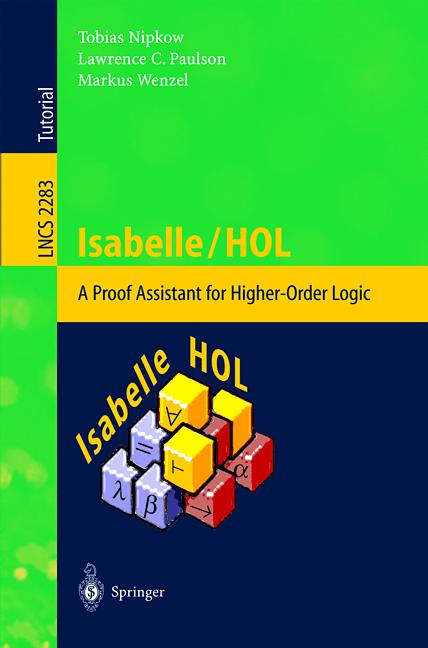I began this series of blog posts one week ago (Jan. 20) by listing 11 serious researchers who have cited or otherwise mentioned my 2013 law review article “Gödel’s Loophole” — to keep my list manageable, I included only scholarly works, thus excluding all general media mentions — and I have since replied to the first nine of those authors. But I have saved the best for last: a 2020 paper by Valeria Zahoransky and Christoph Benzmüller, which builds on previous work by Zahoransky (2019; see here).
To the point, unlike most of the other works in my Jan. 20 listing, Zahoransky & Benzmüller take Gödel’s constitutional contradiction seriously: how to introduce a dictatorship in the USA without violating the rules laid out in the U.S. Constitution. Specifically, they formally model the argument in Part 3 of my paper (i.e. my Gödelian conjecture) with the language of Higher-Order Logic using Isabelle/HOL, a proof assistant for Higher-Order Logic (HOL) (see, for example, the textbook pictured below). From the introduction to their paper (footnotes omitted):
“There is an infamous anecdote [involving Gödel’s citizenship hearing] …. When preparing for the hearing Gödel found that the Constitution allowed for the introduction of a constitutional dictatorship. He set out to explain this to the judge once the discussion turned towards the governmental system of the United States. The judge was not interested in hearing Gödel’s argument but did grant him the US citizenship.
“In the following we shall model an argument for installing lawful dictatorship on the basis of the U.S. Constitution. It is not, however, Gödel own argument, but rather one suggested by legal scholar Guerra-Pujol.”
Zahoransky & Benzmüller then go on to outline my argument as follows:
“… we outline the argument as provided by [Guerra-Pujol, 2013]. The constitution does not allow for the direct installation of a dictatorship,since dictatorship requires the consolidation of legislative, executive and judicial powers in one person or institution [Levinson & Balkan, 2009]. This is not possible due to the separation of powers as set out in U.S. Const. Arts. I-III. In order to allow for this kind of consolidation of powers the Constitution has to be amended in a two-step process. First, an amendment that changes Art.V has to be introduced and secondly an amendment that actually installs dictatorship by consolidating power in one person or institution.
“Art.V needs to be amended since it regulates the amendment process and protects some articles from being amended altogether, such as U.S. Const. Art.I, §3., cl.1 and U.S. Const. Amend. XXVII, which ensure that each state has two votes in Senate. Directly introducing an amendment that would abolish the distribution of powers and thus strip the states of their suffrage rights would not be constitutional. One can however remove the protection of certain articles from Art.V with a first amendment, amd1, and then introduce dictatorship with a second amendment, amd2. This is constitutional since Art.V does not protect itself.”
Among other things, the remainder of their beautiful paper formalizes my reconstruction of Gödel’s loophole by identifying those constitutional provisions that are relevant to my Gödelian conjecture and by representing those provisions in higher order logic (HOL). If I may now be permitted a second-order conjecture, I believe Kurt Gödel himself would have loved it!



